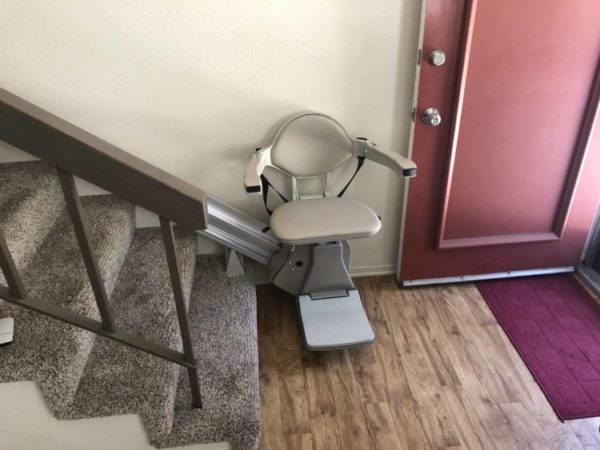Perhaps the biggest question that consumers have when considering stairlifts relates to whether their staircase will accommodate a lift safely. There are few scenarios that make it impossible to implement a lift and mobility experts and retailers can help you trouble-shoot challenges or concerns. Consider using best stairlift practices when dealing with small staircases to keep the user and others safe.
When it comes to implementing stairlifts, some consumers may wonder if their homes meet the eligibility requirements to accommodate these mobility aids and devices, primarily concerned about the size, shape, or width of their staircase.
Some other Stairlift questions include:
- Does the stairlift pose hazard or fall risk to others in the home when it is not in use?
- Can others safely walk past the lift on the risers?
- Is the staircase too narrow for a lift? Is it too small?
- Will a curved or bending staircase accommodate a stairlift?
- What are the lift options for outdoor staircases?
There are some sound stairlift practices that benefit those dealing with such situations, particularly when it comes to smaller staircases. Since you can’t make your stairs bigger overnight, what can you do to facilitate a stairlift? Keep the following tips in mind when weighing your options.
Safety for the User
In order for a stairlift to be safe, it obviously needs to fit the staircase and be installed by qualified mobility professionals. This is not the time to curb costs with second-hand equipment installed by a novice; your health and wellbeing may be at risk! Basically, the width of the staircase is the most important qualifier when it comes to installing a lift in the home. The safety issue impacts both the user and anyone who needs to use the stairs around the lift in the dwelling. Injuries can occur when passers-by hit their knees on the banister or trip over the track. Typically, the stairway must be at least 29-inches wide to accommodate a lift safely; there are some standing-style lifts that require less width but that may cost quite a bit more. Talk with a mobility aid expert and dealer to learn more and identify if your staircase fits the bill for a lift.
Safety for Others
Addressing the safety of others in the home is another issue worth considering before buying your lift. Where will the lift be parked when it is not being used? Will it be possible to safely walk the stairs around the lift and track? Usually, the chair for the lift is perched at the bottom of the stairs; imagine how this would be in your home. It will also be perched at the top of the stairs, level with your landing; do you see room around the landing to safely exit the lift? Talk to vendors about features that can make your lift even more space-efficient, including foldable seats, footrests, and arm-rests, which allow you to save space when the lift is not in use. Furthermore, this presents much less of an obstruction to others when you have limited space on your staircase. A problem may manifest when you have doors either at the foot or top of your stairway; the track and equipment could potentially pose as an obstacle and block access. This is a distinctive situation that merits a conversation with a qualified mobility expert. Don’t make assumptions based on what you have heard; times are changing and mobility aids and stairlifts have come a long way. They are far more versatile and consumer-friendly than they may have been a few years ago. The important thing to remember is safety and to rely on the expertise and knowledge of a qualified and reputable mobility aids vendor when making buying decisions.
Sensible Solutions
There are many sensible solutions through your mobility dealer that addresses and resolves these stairlift situations. From lifts that park behind the banister to foldable tracks that can be stowed when not in use, all stairlifts are not created equal. You might also find power hinged lifts that make it more convenient when there are non-lift users living in and using the same space. As for curves and bends, there is specific equipment to accommodate these unique staircases. Additionally, you will find custom features available to satisfy each and every user.
Think your staircase won’t accommodate a stairlift? Call our Mobility experts to learn more
Before ruling out the possibility of a life-changing stairlift in your home, talk to the mobility professionals at Pacific Mobility; they are happy to discuss the parameters and requirements for lifts of varying sizes as well as other options to make everyday life more accessible. Don’t let mobility threaten your autonomy; visit a mobility aid dealer today.
President, Husband, Father, Grandfather Graduate of UC Davis- Bio Sci Major- Go Aggies! Jeff has extensive experience in all of Pacific Mobility’s products and services, and specializes in accessibility products as well as stairlifts, ceiling lifts and custom wheel chairs. His hobbies include spending time with family, gardening, mountain biking, exercising and off road motorcycle riding.
24 years as Owner/President of Pacific Mobility Center – selling, installing, and servicing stairlifts, porch lifts, ceiling lifts, pool lifts, handicap ramping, specialty wheelchairs, scooters, power wheel chairs, and other power mobility devices
Certified Environmental Access Consultant since 2008
Licensed General Contractor since 1998
Certified Aging in Place Specialist since 2016
Board Member for Home Access Professionals
Member of Association of Members of the Accessibility Equipment Industry (AEMA)




